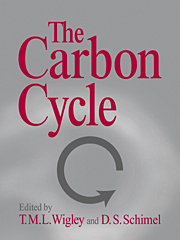Book contents
- Frontmatter
- Contents
- Preface
- Acknowledgments
- Contributors to the 1993 Global Change Institute
- I INTRODUCTION
- II THE MISSING CARBON SINK
- 3 Carbon Dioxide Emissions from Fossil Fuel Consumption and Cement Manufacture, 1751–1991, and an Estimate of Their Isotopic Composition and Latitudinal Distribution
- 4 Emissions of Carbon from Land-Use Change
- 5 The CO2 Fertilizing Effect: Relevance to the Global Carbon Cycle
- 6 Soils and the Global Carbon Cycle
- 7 Grasslands and the Global Carbon Cycle: Modeling the Effects of Climate Change
- 8 Constraints on the Atmospheric Carbon Budget from Spatial Distributions of CO2
- 9 Estimating Air–Sea Exchanges of CO2 from pCO2 Gradients: Assessment of Uncertainties
- 10 Atmospheric Oxygen Measurements and the Carbon Cycle
- 11 A Strategy for Estimating the Potential Soil Carbon Storage Due to CO2 Fertilization
- III PALEO-CO2 VARIATIONS
- IV MODELING CO2 CHANGES
- Part V Appendixes
- Index
10 - Atmospheric Oxygen Measurements and the Carbon Cycle
from II - THE MISSING CARBON SINK
Published online by Cambridge University Press: 04 December 2009
- Frontmatter
- Contents
- Preface
- Acknowledgments
- Contributors to the 1993 Global Change Institute
- I INTRODUCTION
- II THE MISSING CARBON SINK
- 3 Carbon Dioxide Emissions from Fossil Fuel Consumption and Cement Manufacture, 1751–1991, and an Estimate of Their Isotopic Composition and Latitudinal Distribution
- 4 Emissions of Carbon from Land-Use Change
- 5 The CO2 Fertilizing Effect: Relevance to the Global Carbon Cycle
- 6 Soils and the Global Carbon Cycle
- 7 Grasslands and the Global Carbon Cycle: Modeling the Effects of Climate Change
- 8 Constraints on the Atmospheric Carbon Budget from Spatial Distributions of CO2
- 9 Estimating Air–Sea Exchanges of CO2 from pCO2 Gradients: Assessment of Uncertainties
- 10 Atmospheric Oxygen Measurements and the Carbon Cycle
- 11 A Strategy for Estimating the Potential Soil Carbon Storage Due to CO2 Fertilization
- III PALEO-CO2 VARIATIONS
- IV MODELING CO2 CHANGES
- Part V Appendixes
- Index
Summary
Abstract
Precise measurements of atmospheric O2 concentration can provide constraints on several aspects of the global carbon cycle. Seasonal variations in O2 concentration, driven in part by biological and physical cycles in the ocean, can be used to constrain seasonal net photosynthesis rates of marine biota. Interannual variations in O2 concentration, driven largely by O2 uptake by fossil fuel burning and O2 exchanges with land biota, can be used to partition the net global uptake of anthropogenic CO2 into oceanic and land biotic components. The latter application is potentially complicated, however, by interannual sources and sinks of O2 from the ocean. Model simulations are presented that suggest that interannually driven air–sea O2 exchanges may be several times larger on a mole-for-mole basis than interannually driven air–sea CO2 exchanges.
Introduction
It has recently become feasible to measure the atmospheric oxygen concentration to a degree of precision that allows for the detection of variations in the remote atmosphere (Keeling and Shertz, 1992; Bender et al., 1994; Bender et al., 1996; Keeling et al., 1996). These variations primarily reflect changes in O2 because N2 is constant to a very high level. Variations in O2 are caused primarily by production and consumption of O2 by photosynthesis, respiration, and combustion, and are thereby tied to the rate at which carbon is transformed between organic and inorganic forms.
- Type
- Chapter
- Information
- The Carbon Cycle , pp. 134 - 140Publisher: Cambridge University PressPrint publication year: 2000
- 6
- Cited by



